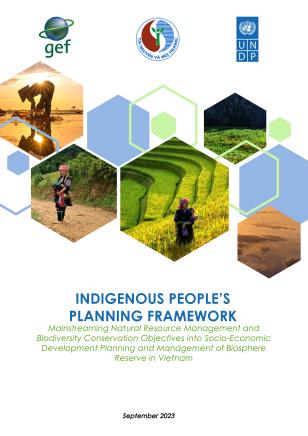Indigenous People’s Planning Framework

Indigenous People’s Planning Framework
October 13, 2023
The Indigenous People’s Planning Framework (IPPF) has been prepared in support of the GEF project “Mainstreaming Natural Resource Management and Biodiversity Conservation Objectives into Socio-Economic Development Planning and Management of Biosphere Reserve in Vietnam” by the Government of Vietnam and UNDP.
The IPPF forms part of the overall project Environmental and Social Management Framework (ESMF) and should be read in conjunction with that document. The implementation of the IPPF is inextricably linked to the implementation of the ESMF.
As the term ‘indigenous peoples’ is not used by the Government of Vietnam, for the purpose of this IPPF, the term ‘ethnic minority’’ (EM) will be used and can be interpreted to mean ‘indigenous people’ in reference to project related items and the Vietnamese context. In this context, ‘ethnic minority’ groups referenced here are consistent with UNDP’s SES and encompasses all such groups that would be identified as indigenous peoples per SES.
The Government of Vietnam recognises 54 ethnic groups, and of the 54 ethnic groups, Kinh is the majority group, accounting for 85.3% of the total population. The 2019 census provides the following ethnic population breakdown: Kinh (82,085,826 or 85.3%), Tày (1,845,492 or 1.9%), Thái (1,820,950 or 1.9%), Hoa (749,466 or 0.78%), Khmer (1,319,652 or 1.4%), Mường (1,452,095 or 1.5%), Nùng (1,083,298 or 1.1%), Mông (1,393,547 or 1.4%), Dao (891,151 or 0.93%), Gia Rai (513,930 or 0.53%), Ê Đê (398,671 or 0.41%), Ba Na (286,910 or 0.30%), Xơ Đăng (212,277 or 0.22%), Sán Chay (201,398 or 0.21%), Cơ Ho (200,800 or 0.21%), Chăm (178,948 or 0.19%), Sán Dìu (183,004 or 0.19%), Hrê (149,460 or 0.16%), Mnông (127,334 or 0.13%), Raglay (146,613 or 0.15%), Xtiêng (100,752 or 0.10%), Bru Vân Kiều (94,598 or 0.098%), Thổ (91,430 or 0.095%), Giáy (67,858 or 0.071%), Cơ Tu (74,173 or 0.077%), Gié Triêng (63,322 or 0.066%), Mạ (50,322 or 0.052%), Khơ Mú (90,612 or 0.094%), Co (40,442 or 0.042%), Tà Ôi (52,356 or 0.054%), Chơ Ro (29,520 or 0.031%), Kháng (16,180 or 0.017%), Xinh Mun (29,503 or 0.031%), Hà Nhì (25,539 or 0.027%), Chu Ru (23,242 or 0.024%), Lào (17,532 or 0.018%), La Chí (15,126 or 0.016%), La Ha (10,157 or 0.011%), Phù Lá (12,471 or 0.013%), La Hủ (12,113 or 0.013%), Lự (6,757 or 0.0070%), Lô Lô (4,827 or 0.0050%), Chứt (7,513 or 0.0078%), Mảng (4,650 or 0.0048%), Pà Thẻn (8,248 or 0.0086%), Cơ Lao (4,003 or 0.0042%), Cống (2,729 or 0.0028%), Bố Y (3,232 or 0.0034%), Ngái (1,649 or 0.0017%), Si La (909 or 0.00094%), Pu Péo (903 or 0.00094%), Brâu (525 or 0.00055%), Ơ Đu (428 or 0.00044%), and Rơ Măm (639 or 0.00066%).
Vietnam voted in favour for the UN Declaration on the Rights of Indigenous Peoples (UNDRIP). The United Nations Framework on Convention on Climate Change (UNFCCC) recognises the importance of engaging with indigenous people on climate change policies and actions as well as the need to strengthen their efforts in addressing and responding the impacts of climate change.
Recognising the invaluable contributions of indigenous peoples in climate change adaptation and mitigation as well as the threats they continue to face, the GCF’s Indigenous Peoples’ Policy aims for indigenous peoples to benefit from project activities and ensure that they do not suffer from the design and implementation of the projects.
UNDP engagement with indigenous peoples is guided by the universal human rights standards and principles, particularly the UNDRIP. UNDP supports capacity building of indigenous peoples’ organisations through different programmes globally and works with other UN organisations through the United Nations Indigenous Peoples Partnership. As an accredited entity of the GEF, UNDP’s role is to ensure that indigenous peoples in the project area are properly consulted and that their views are taken into consideration into the planning process.
This IPPF has been drafted considering the GEF’s Indigenous Peoples Principles and Guidelines for Engagement with Indigenous Peoples (2012), UNDP’s Social and Environmental Safeguards Policy as well as good practices of indigenous peoples planning framework of other multilateral agencies, while being guided by the relevant national regulatory frameworks on indigenous peoples.

 Locations
Locations




